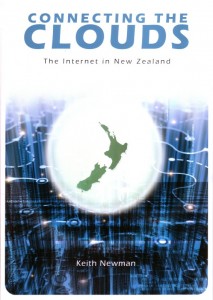Veteran telecommunications reporter Keith Newman’s epic history of the  internet in New Zealand is in bookshops now and in a particularly progressive move is being made available online for free in wiki form.
internet in New Zealand is in bookshops now and in a particularly progressive move is being made available online for free in wiki form.
At 700 pages, Connecting the Clouds is a substantial piece of work and in fact was extended massively beyond its original intended length of around 100,000 words.
If you’re looking for a fast-paced yarn in the style of the multitude of books outlining Silicon Valley’s pioneering personalities and companies, you won’t find it here. Connecting the Clouds is a fairly dry and earnest historical record those with a casual interest in technology and the internet will find hard to digest.Telecoms industry insiders on the other hand will bask in nostalgia as they are reminded of the clunky network boxes that first ran the internet from Victoria University’s machine room or the ealry days of the Xtra ISP service.
Newman dedicates the book to “New Zealand’s number 8 wire communications pioneers and entrepreneurs” and it is those early engineers, academics and entrepreneurs responsible for the development of the internet in New Zealand in the 1980s and early 1990s that the book pays most attention to.
Before that however, he starts out with a brief but interesting history lesson about the first telegraph cables laid in the 1860s. Who would have known that the first copper cable across Cook Strait was insulated with “coagulated latex” derived from trees grown in Malaya?
Fairly swiftly he moves on to the 70s, the development of university IT networks, the DSIR’s scientific computing efforts and the Post Office’s dragging of the chain when it came to upgrading its infrastructure to meet the changing communications needs of the country.
The personalities who played leading roles during this period, the likes of John Hine at Victoria University, and Frank March who also ended up at the university following a long stint at the DSIR, get a lot of play before Newman focuses on the disasterous deregulation of the telecoms market in the aptly titled chapter Selling the family jewels.
Telecom’s presence looms large in the book with later chapters pre-occupied with the monopoly provider’s attempts to squash competition as innovative rivals like ihug began to emerge and the country crawled towards local loop unbundling.
While the early commercial pioneers of internet services, the likes of Isocnz, Actrix and Voyager, feature in Connecting the Clouds, the later set of entrepreneurs we currently associate with the New Zealand internet get surprisingly little mention. The Trademe story is dealt with fleetingly and New Zealand’s pioneering web 2.0 cottage industry hardly gets a look-in.
But Newman can’t be faulted in his methodical research methods which chart the key technical, regulatory and commercial developments that determined the shape of the internet. The detail is extraordinary and I’m glad someone has put it all on the record for the first time.
All up, I look at Connecting the Clouds the same way I do the old clippings in my scrapbooks covering years of telecoms and IT reporting I did on the Herald. It all seemed like frightfully important stuff at the time but in hindsight really just amounted to a bunch of logistical decisions, regulatory pressures and technical undertakings that allowed us to get to a place where we can connect to the world and each other the way we do today. Hardly the makings of a gripping read then, but a worthy reference for those with an eye for the detail.
Newman’s interview with Simon Morton on Radio New Zealand.